In June, the Children of Vietnam Charitable Fund provided support for the surgical correction of a congenital chest deformity. The patient, a nine-year-old boy from the E De ethnic minority group named Bdap, received specialist care at FV Hospital to repair the depression in his chest which was compressing his lungs and causing health issues.
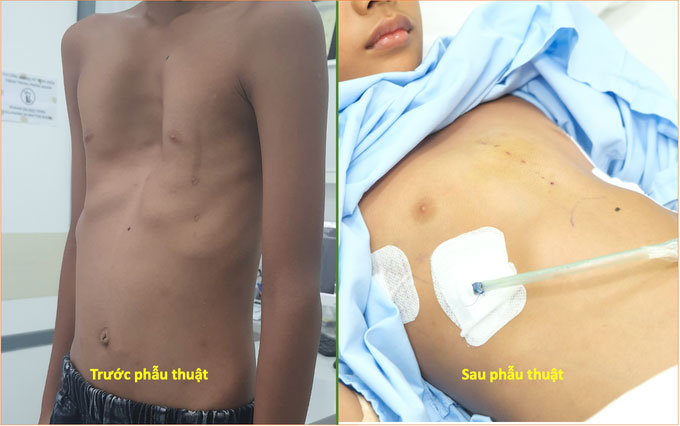
Before and after photos of Bdap’s successful surgery to correct a chest deformity at FV Hospital
Bdap’s parents felt very sad about his severely deformed chest as they lacked the means for treatment
Bdap, a nine-year-old boy from Ea Hu commune, Cu Kuin District, Dak Lak Province, is currently in fourth grade but weighs only 18 kilograms. He was born with a deep depression in his chest which has worsened over time, and is now almost the size of a rice bowl, leading to lung inflammation, deformity, and severe malnutrition. Unfortunately, his family did not have the means to seek treatment.
Mr Y-Khing, Bdap’s father, shared his sorrow, saying that he noticed the chest depression right after his child was born and anxiously watched it deepen as Bdap grew.
“As a father, it pains me to see my child in this condition. I really wanted to take him for medical treatment, but our family’s circumstances didn’t allow it. We had to reluctantly let him live with the deformity, and he has had to endure many complications due to lung inflammation,” shared Mr Y-Khing.
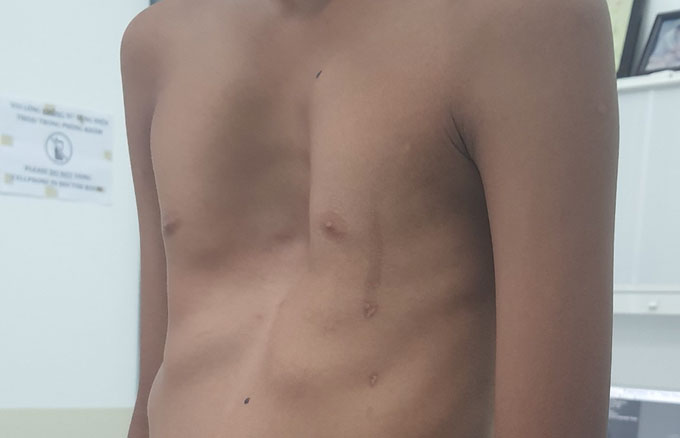
Bdap’s deep chest depression compressed his lungs.
Mr Y-Khing works as a welder while his wife takes care of their four young children at home. The family faces difficult circumstances as Mr Y-Khing’s income is not enough to cover daily expenses, resulting in the family’s food insecurity. Seeking medical examination and treatment for Bdap has always been beyond the family’s financial means.
As Bdap’s chest depression deepened, he experienced frequent lung inflammation and prolonged hospitalisations. Initially, the family could only afford local medical consultations and treatment. However, during a severe bout of pneumonia, Bdap had to be transferred to Children’s Hospital 2 for further treatment.
“At that time, the doctor mentioned that if we had resources, we should seek early treatment for our child. However, as we lacked adequate financial income, we returned home feeling helpless and devastated for our child. Bdap is carefree and cheerful, but he cannot engage in running and jumping activities for long as he easily gets tired,” shares Bdap’s father.
In April 2023 the Children of Vietnam Charitable Fund at FV Hospital collaborated with Dak Lak province to conduct screenings for children in the region and became aware of Bdap’s case. Considering the family’s difficult circumstances and the child’s condition, the Fund decided to sponsor the expenses for Bdap’s surgery and recovery, enabling him to regain his health and enjoy playing and running like his peers.
Mr Y-Khing expressed his joy and gratitude upon receiving news of the sponsorship from the “Nâng bước tuổi thơ” Fund for his son’s treatment. He planned to take time off work to bring Bdap to Ho Chi Minh City for hospitalisation and surgery.
FV restores chest deformity for Bdap using improved Nuss technique
Dr Luong Ngoc Trung, Vascular Surgery & Phlebology Department at FV Hospital, states that chest deformity is a congenital condition that develops over time, with an average of 300-400 children born with this condition every year, accounting for a rate of 0.25-0.3% of live births. Chest deformity can also occur in adults if not treated during childhood.
When chest deformity in children is diagnosed, physicians conduct clinical examinations and use computed tomography (CT) scans to calculate the Haller index to assess the severity of the deformity and associated lung damage.
According to the Haller index, if the value is above 3 (especially above 3.2), surgery is recommended for correct the depression. The ideal age for surgical intervention is between nine and 15 years old as this age range allows for easier correction of the skeletal structure. Beyond this age, the skeletal structure becomes rigid, making it more difficult to correct and resulting in more post-operative pain.
“Bdap’s Haller index is 6.0. This is a severe case that requires surgery,” says Dr Trung.
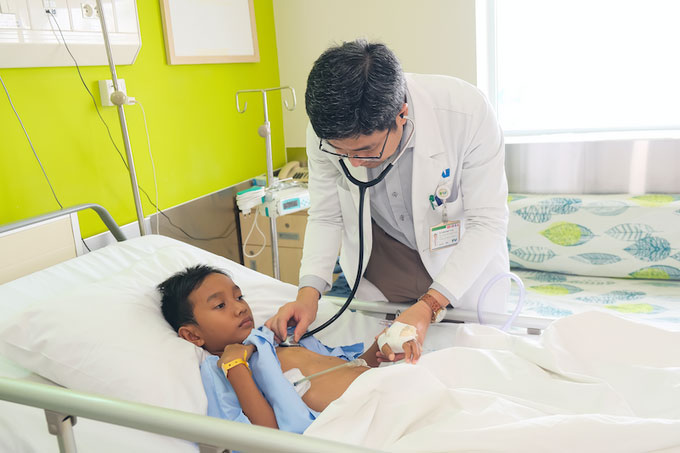
Dr Luong Ngoc Trung examined Bdap.
The computed tomography (CT) scan revealed that Bdap has developed complications in his right lung, including a large pneumothorax that occupies half of the lung, narrowed bronchial branches, and limited functionality of the remaining lung. The consequences of these injuries result in poor lung function, stagnant air in the lungs, and an increased risk of pneumonia and infection.
Similar effects also impact the cardiovascular system, causing the child to easily become fatigued, limited in physical activities, prone to malnutrition, and to develop spinal deformities. These issues may also cause barriers to social integration with their peers.
Dr Ngoc Trung explained this condition was historically treated by cutting and reshaping the ribs, which was extremely painful for patients in recovery. In 1980, the Nuss technique was introduced, which utilised a curved metal bars to push the breastbone forward and is more effective and less invasive then the previous method. Subsequent improvements, especially the combination with endoscopic surgery, have simplified the procedure and reduced the risk of complications.
“However, the limitation of this technique is its inability to address complex deformities involving the sternum and ribs, causing discomfort as the metal bar is attached to the ribs and may shift during the child’s movements,” emphasises Dr Trung.
In recent years, the Nuss technique has been further enhanced with the introduction of the “Sandwich” technique, which requires two metal bars. This technique overcomes the limitations of the classical single-bar Nuss surgery and allows for the correction of complex deformities.
Dr Ngoc Trung performed the surgical procedure for Bdap. “As this is a congenital condition, parents need to be vigilant in detecting any abnormalities in their child’s chest and promptly seek medical attention for the management of pectus excavatum. Mild cases can potentially be improved through physical therapy. Severe cases, if identified and treated early, can yield better outcomes and prevent long-term complications,” shares Dr Trung.
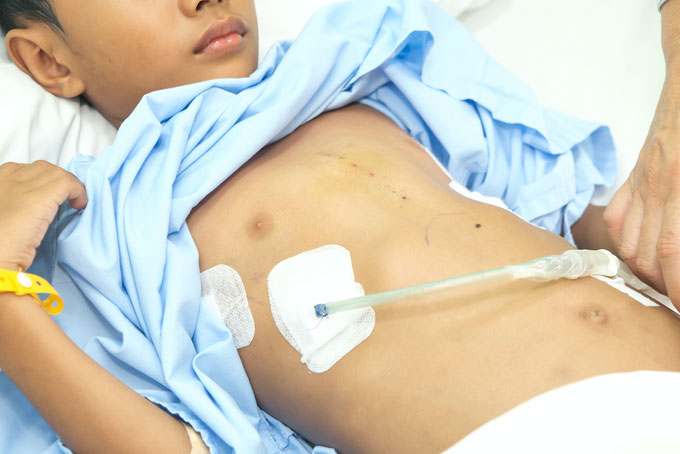
Bdap’s chest returns to normal after the surgical procedure.
After the surgery, Bdap recovered well and his condition was good. On the third day, post-surgery, his parents reported that Bdap was feeling much better and could possibly be discharged from the hospital in one or two days. Bdap will return to FV in approximately two years to have the chest brace removed.
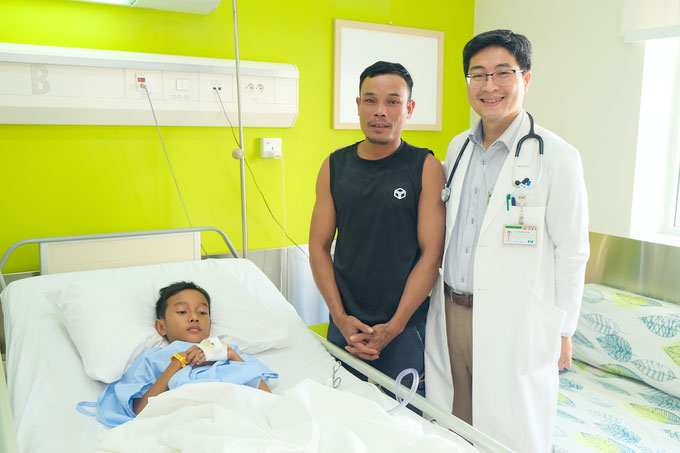
Dr Luong Ngoc Trung, Mr Y-Khing and Bdap after the surgery.
Before discharge, Mr Y-Khing expressed his heartfelt gratitude to the doctors at FV Hospital, as well as the Children of Vietnam Charitable Fund. “Thanks to the Fund and FV’s doctors, my son has recovered well and has the opportunity to develop normally like other children his age,” says Mr Y-Khing.



